China’s trade data for July, released on Monday, showed a weaker-than-expected performance of the world’s second-largest economy. The country’s exports grew by 19.3% year-on-year, down from 32.2% in June and below the market consensus of 20.8%. Imports rose by 28.1%, also slower than the previous month’s 36.7% and the forecast of 33%. The trade surplus narrowed to $56.58 billion, missing the estimate of $51.54 billion.
The slowdown in trade reflects the impact of the COVID-19 Delta variant, which has caused outbreaks and lockdowns in some parts of China and its trading partners. The supply chain disruptions, rising raw material costs, and environmental regulations have also weighed on the export sector. The import growth was dragged down by lower commodity prices and weaker domestic demand.

China’s credit impulse hits lowest level since 2009
Another worrying sign for China’s economy is the decline in its credit impulse, which measures the change in new credit as a percentage of GDP. According to Reuters, China’s credit impulse fell to -6.9% in June, the lowest level since 2009, indicating a sharp contraction in credit growth.
The credit impulse is a leading indicator of economic activity, as it reflects the availability and cost of financing for businesses and consumers. A negative credit impulse means that the amount of new credit issued is less than the amount of credit that is repaid or written off, implying a tightening of monetary conditions.
The decline in China’s credit impulse suggests that the authorities have been reluctant to provide more stimulus to the economy, despite the signs of slowing growth and deflationary pressures. The official stance has been to maintain a “prudent” monetary policy and a “proactive” fiscal policy, while avoiding excessive easing or tightening.
Will China pull the stimulus trigger?
The question that many investors and analysts are asking is whether China will change its policy stance and inject more stimulus into the economy, especially after the disappointing trade data and the weak credit impulse. Some market participants are betting that Beijing will soon announce more measures to support growth, such as cutting interest rates, lowering reserve requirement ratios (RRR), increasing fiscal spending, or easing regulatory curbs.
However, others are more skeptical about the prospects of a major stimulus package from China, arguing that the authorities are more concerned about the long-term risks of debt accumulation, financial instability, and environmental degradation. They believe that Beijing will only resort to targeted and calibrated easing, such as providing liquidity to specific sectors or regions, rather than a broad-based stimulus that could fuel asset bubbles or inflation.
The answer may depend on how China’s economy fares in the coming months, as it faces multiple challenges from the pandemic, geopolitics, and structural reforms. The market will also pay close attention to the upcoming data releases from China, such as retail sales, industrial production, house prices, GDP, and inflation, which could provide more clues about the state of the economy and the policy direction.
